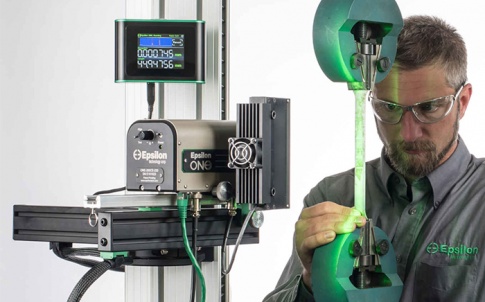
The Tinius Olsen Epsilon ONE is a new optical non-contact extensometer performing high- accuracy, high-resolution, non-contacting axial strain and displacement measurement, using video to measure strain. It is unique in its ease of use for efficient materials testing.
It is suitable for testing high-modulus materials such as metals and composites and higher- elongation materials, thin or delicate specimens, cyclic fatigue, strain controlled testing, deflectometer applications and measuring crack opening displacements.
Class-leading accuracy and resolution are achieved by Epsilon’s comprehensive optical path optimisation, thanks to a unification of several optical technologies and signal processing algorithms.
Its ultra-high camera resolution, real-time data rates up to 3000Hz, minimisation of optical error sources and signal processing techniques provide high strain resolution and accuracy with the lowest noise.
Strain or extension is measured and output in real time. Epsilon ONE’s high resolution and ISO 0,5 / ASTM B-1 accuracy classes make it suitable for non-contact measurement of a wide range of strain values, from very small strains required to measure modulus of metals, composites, ceramics and CMCs through elastomers and everything in between.
“It is so straight forward to use, perfect for busy Labs. Simply place the specimen in the testing machine, swipe your hand to break the light path to zero and start, that’s it.” said Martin Wheeler, Director of Sales and Business Development at Tinius Olsen.
“Epsilon ONE doesn’t have to be started and stopped for each specimen like most video extensometers and DIC systems, with Laser-Assist Alignment System providing an instant alignment and distance spot check. This projects pre-aligned laser lines on the specimen before the test to reveal any misalignment.
“During the test, high precision tele-centric lenses eliminate errors due to out-of-plane movements on low strain materials and components.”
“All these factors result in Epsilon ONE being equipped with the accuracy and fine resolution required to measure modulus, offset yield, stress-strain curves and strain at failure for all high- modulus materials.”
Many applications involve specimens that straighten or grips that are free to align under tensile loading. Unlike conventional lenses, tele-centric lenses are insensitive to potential inaccuracies caused by these out-of-plane motions. With a tele-centric lens, the image of the test specimen seen by the camera’s sensor is the same size even if the specimen moves closer to the Optics Package or further away.
This gives the benefit of maintaining full strain measurement accuracy, even if the specimen or grips move “out of plane” during the test. Conventional ento-centric lenses, which are widely used by other manufacturers of non-contact extensometers, cannot match this performance.
“One of the biggest barriers to widespread use of non-contact extensometers to overcome are too many steps when using them. Epsilon ONE is always running and measuring strain or searching for marks using its Automatic Mark Detection. As soon as marks are detected, Epsilon ONE is measuring strain in real time,” continued Martin.
“Most materials testing technologies perform as certified day in day out. What sets the Tinius Olsen system apart is its ability to drive up productivity. Seconds per test adds up to weeks in a year - and that equates to money!”
“The Tinius Olsen Epsilon One sets up for new specimen types in minutes, requires very little training or skill to use, and fits all models of materials testing machines. We strongly believe the Epsilon One is a real step evolution in the world of materials testing.”
For further information on Epsilon One contact Richard Coombes on 01737 765001 visit Tinius Olsen










Water Sector Talent Exodus Could Cripple The Sector
Well let´s do a little experiment. My last (10.4.25) half-yearly water/waste water bill from Severn Trent was £98.29. How much does not-for-profit Dŵr...